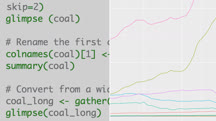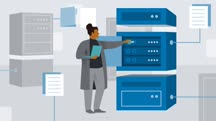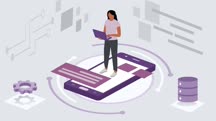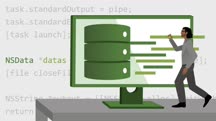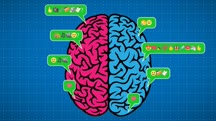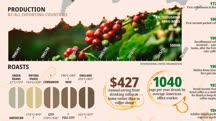Course catalog
Categories
Showing 401-420 of 1,450 items.
Data Wrangling in R (2017) (226743)
Tidy data is a data format that provides a standardized way of organizing data values within a dataset. By leveraging tidy data principles, statisticians, analysts, and data scientists can spend less time cleaning data and more time tackling the more compelling aspects of data analysis. In this course, learn about the principles of tidy data, and discover how to create and manipulate data tibbles—transforming them from source data into tidy formats. Instructor Mike Chapple uses the R programming language and the tidyverse packages to teach the concept of data wrangling—the data cleaning and data transformation tasks that consume a substantial portion of analysts' time. He wraps up with three hands-on case studies that help to reinforce the data wrangling principles and tactics covered in this course.
Database Foundations: Administration (229905)
Ongoing, regular administration is critical to the security and performance of databases such as SQL Server. In this course—the fourth installment in the Database Foundations series—explore vital techniques and best practices for administering a database. Instructor Adam Wilbert covers a variety of core concepts, including how to secure a server with user authentication and roles, protect your database by setting up permissions for authorized user accounts, and perform a backup and restore. Adam also offers expert tips for ensuring that a database remains available, even through hardware maintenance, upgrades, and failures. Along the way, he provides tips for working effectively with both SQL Server and PostgreSQL.
Database Foundations: Application Development (229922)
While learning about the individual components of a software development stack like databases, programming languages, and interfaces is important, combining multiple technologies that each contribute a piece to the whole is where all the knowledge really comes together. In this fifth and final course of his Database Foundations series, database expert Adam Wilbert explores the role of relational databases in the larger landscape of application development. He examines the architecture of modern apps and how databases integrate with presentation and logic, and how all these building blocks of software development fit together. To do so, Adam shows two different approaches of how to integrate a database with a web server and details the components that allow you to build custom interfaces for your data, in order to provide end users access to your databases from any web browser.
Databases for Node.js Developers (221116)
Node.js developers often consider MongoDB to be their main choice when building a data-driven application—but many alternatives may provide better solutions. In this course, learn about the various database options available for Node.js applications, so that you can select the right database for your app. Daniel Khan reviews the basics of relational and nonrelational databases, and explains how—and when—to use document databases with Node.js. He also covers using key-value stores and relational databases with Node.js, demonstrating how to work with MySQL and Sequelize.
DaVinci Resolve Fundamentals (222646)
Are you new to DaVinci Resolve? Are you intrigued by the power of this digital video media creation tool? Do you find the power of this tool intimidating or confusing? Then this title is for you. Join instructor and professional colorist Patrick Inhofer in this course designed to get you up to speed in as little time as possible. This course includes a 60-second commercial for you to work with so you can get comfortable with the layout and workflow as you follow along. Patrick starts with the process of importing your media, using both manual and automated tools, before showing how to start building a rough cut in Resolve. He then explains how to refine your rough cut using trim tools and adding titles and transitions, details the important aspects of color correction, and shows how to organize and mix sound clips. Patrick finishes the course covering the export process, showing how to use preset templates as well as how to create your own reusable custom templates.
DaVinci Resolve: Color Page (221796)
DaVinci Resolve is a leading professional color grading solution used for digital intermediates (the digital color grading of film-acquired sources, to be printed back out to film for theatrical exhibition). It’s not surprising that its color management tools are used every day in major film productions all over the world. In this course, professional colorist Patrick Inhofer takes an extensive look at the color page in DaVinci Resolve, starting with the settings and preferences that have a significant impact on color manipulations. He then covers the concept of primary corrections and the tools used for establishing a base color correction, as well as secondary corrections and how to isolate and minimize problematic areas of the image. Patrick also shows how to combine primary and secondary color operations to enhance viewer engagement, and shares tips for improving your shot-matching skills to help your story have a better visual flow.
This course was created by Patrick Inhofer. We are pleased to host this training in our library
This course was created by Patrick Inhofer. We are pleased to host this training in our library
DaVinci Resolve: Software Features and Workflows (222085)
DaVinci Resolve is constantly being updated and refined. In this course, instructor Patrick Inhofer shows you how to work smarter with this feature-rich platform, sharing important workflows and options that every Resolve editor, colorist, VFX artist, or audio mixer should understand. Learn how to efficiently manage databases and project files, customize the user interface to suit your personal preferences, and optimize playback performance—including how to leverage Render Cache and proxy options. Plus, discover how to move a project between Premiere Pro or Final Cut Pro and DaVinci Resolve, as well as add additional hardware to speed up your editing, color grading, or mixing workflows.
DBeaver Essential Training (230721)
Are you looking for an alternative to your database platform’s native tools? DBeaver is the universal database client that allows you to work with a wide variety of data platforms from a single interface. In this course, database expert Adam Wilbert shows you how to leverage this powerful tool. Adam gives you a tour of the interface and explains how to create your own database connections and add a PostgreSQL connection. He steps through how to use projects to organize your workspace, as well as the views, filters, and panels you might use when working with tabular data. After exploring how to create and modify database objects and structures, Adam covers how to configure, save, and print an entity relationship (ER) diagram. He offers useful tips on writing commands with the SQL Editor, then concludes with a discussion of some additional features that you might use in the Enterprise Edition.
De-Escalating Conversations for Customer Service (227338)
Nearly every customer service professional has encountered a livid customer. These individuals may yell, curse, or forcefully disagree with a policy that you must enforce, but can't control. Such situations are unquestionably tough, but—with the right approach—you can consistently de-escalate the tension. In this course, instructor Myra Golden shares strategies for defusing intense situations, providing practical approaches that can help you calm angry customers. Myra goes over what often causes situations to escalate, and shares practical steps you can take to prevent an escalation. She also provides tips that can help you reframe conversations, manage expectations, handle customers who ask for your supervisor, and more.
Dealing with Microaggression as an Employee (216934)
In this course, Toni Lowe, a sought-after speaker and senior HR leader specializing in diversity, inclusion, equity, and belonging, teaches you how to identify and address everyday, subtle, intentional and unintentional actions or behaviors that perpetuate bias toward marginalized groups in the workplace. Toni defines microaggression and identifies the three distinct types of microaggressions: microassaults, microinsults, and microinvalidations. While the word "micro" means "small," each instance of microaggression has a big impact on the employee experience, physical health, and psychological well-being. Toni provides actionable steps you can take to create safe spaces in the workplace for coping and developing a support system. She discusses how to effectively address past behaviors directly with the offender or through a third party, then walks you through how to deal with microaggressions in real time. Toni concludes with her three-step framework for dealing with microaggression.
Deep Learning Foundations: Natural Language Processing with TensorFlow (220572)
There is a growing demand to harness the power of natural language processing (NLP) and deep learning models to be able to make sense of textual data and reduce the emotional intervention of humans in order to make better decisions. In this course, instructor Harshit Tyagi provides a complete guide to understanding NLP using recurrent neural networks (RNNs). Harshit begins by introducing you to word encodings and using TensorFlow for tokenization. He describes the important concept of word embeddings and shows you how to use TensorFlow to classify movie reviews and project vectors. Harshit discusses RNNs and long short-term memory (LSTM), then shows you how to improve the movie review classifier from earlier in the course. He concludes with a discussion of how you can train RNNs to predict the next word in a sentence, which in turn allows you to generate some original text.
Delivering an Authentic Elevator Pitch (226301)
Find out how to craft an authentic personal pitch while projecting competence and warmth—two key factors in making a great first impression. Instructor Tatiana Kolovou shares how building trust with people and making a positive first impression isn’t a matter of magic. Tatiana reveals how verbal and nonverbal behaviors can influence the way people react in an initial meeting, whether in person, over the phone, or online.
Demonstrating Accountability as a Leader (231214)
Leadership accountability is at the heart of any organization’s ability to achieve optimal performance. At a time when we continue to experience accelerated change, increased complexities, growing pressures, and competing priorities, leaders set the tone in their companies and establish the culture by how they treat others and by how they live their values. Yet many organizations miss opportunities to demonstrate leadership accountability. In this course, learn about what leadership accountability is, why it matters to organizations, and what actions leaders should take to practice accountability. Instructor Dr. Shirley Davis describes strategies for taking ownership as a leader, making effective decisions, and demonstrating accountability in the way you communicate with others.
Demystifying Audio Synthesis: Beyond The Basics (230466)
Up your levels. Move beyond the basics of sound synthesis, in this course with musician Scott Hirsch. These advanced tutorials explore the inner workings of familiar synth programming techniques, as well as a few alternatives for pushing your sound further. Scott builds from modular-component synthesis to other types of synthesis, including frequency-modulation (FM) synthesis, modeling synthesis, and vocoding techniques. The course finishes up with a series of tutorials on creating new sounds, including a classic vocoder effect, big moving basslines, evocative percussion patterns, and rich synth pads.
Note: Scott uses a combination of Ableton Live, Native Instruments software, and Logic Pro in this course, but you can easily recreate the techniques in the DAW of your choice. The specific synths used include Native Instruments Massive; Logic Pro Alchemy and the Sculpture plugin; and Collision in Abelton Live.
Note: Scott uses a combination of Ableton Live, Native Instruments software, and Logic Pro in this course, but you can easily recreate the techniques in the DAW of your choice. The specific synths used include Native Instruments Massive; Logic Pro Alchemy and the Sculpture plugin; and Collision in Abelton Live.
Demystifying Company Culture (227729)
A bad company culture is often easy to identify and explain, but a great company culture can seem elusive and difficult to achieve. Many organizations throw things at the wall, seeing what will stick, which results in a lot of wasted expenses and frustrated employees. If understanding company culture seems challenging, try to instead understand employee engagement. In this course, human resources expert and podcast host Katrina Ghazarian explains how engagement is the foundation that leads to a positive company culture. Katrina walks viewers through defining company culture, measuring employee engagement, and making changes that lasts and improve culture. After this course, you’ll have a clear idea on what company culture is made of, how to manage it, and how to communicate company culture with employees.
This course was created by Madecraft. We are pleased to host this training in our library.

This course was created by Madecraft. We are pleased to host this training in our library.

Deploying Azure Active Directory (209624)
Want to learn how to manage cloud identities in Azure Active Directory? You’re in the right place. This course provides in-depth instruction regarding the day-to-day tasks that Azure Active Directory administrators must perform after rolling out the enterprise identity service. Instructor Kunal D Mehta provides important considerations and hands-on demonstrations for each step. For users and groups, Kunal explains the various types of accounts and how to create, read, update, and delete user accounts and groups. He also presents the different methods of management used for hybrid versus native or on-premises users. Plus, discover three device management strategies, explore key concepts around planning a hybrid identity infrastructure, and review a checklist you can use while evaluating a hybrid strategy for your own organization.
Design Thinking, Social Innovation, and Complex Systems (216220)
Silicon Valley has always attracted talented designers looking to improve user experience. But designers can improve the human experience too. Social innovation is the process of developing and deploying effective solutions to challenging and often systemic social and environmental issues. This course is for those who want to use social innovation and design thinking to achieve big results for their communities. Get ready to discover design opportunities to reimagine human behavior. Find out to break down impenetrable and unpredictable problems using concepts like the iceberg model and nested systems. Then find out how design can serve the higher purposes of inclusivity and social justice. Instructor and sustainable design expert Scott Boylston explains the relationship between design thinking and social innovation and teaches us about the impact design can have on global goals, including sustainable development, anti-racism, and equality.
Design Tools Weekly (221745)
Get something new from the world of design every Tuesday in Design Tools Weekly. Designer and Illustrator Tony Harmer shares tips, tricks, and techniques with design tools to inform, inspire, and entertain each week. He tackles programs that you’re probably familiar with, and reveals others that maybe you’ve missed from the desktop, mobile, and analog world. Learn how to create color harmonies to use in any project, build animated GIFs quickly, make custom brushes, use variable fonts effectively, and much more. Design tools—and trends—evolve every day; this course will help you stay on top of the latest advancements and help you be more efficient at every step.
Note: Because this course is an ongoing series, viewers will not receive a certificate of completion.
Note: Because this course is an ongoing series, viewers will not receive a certificate of completion.
Designing a Presentation (214843)
Perhaps the most essential skill for all knowledge workers, sales professionals, business owners, and educators is the ability to design compelling presentations. Whether you’re reporting performance metrics, delivering a training, or pitching a big idea, you need a presentation to support you and illuminate your speech. In this course, designer Tony Harmer takes you through the essentials of presentation design to give you the tools you'll find most useful in thinking about, designing, and building successful presentations. Tony covers a variety of key topics, including moodboards, outlines, layout, type and text, color considerations, graphics, video, charts, transitions, and animations. He concludes with some useful advice on finishing touches and follow-ups for your presentation.
Designing an Infographic (221762)
Numbers and figures and statistics are, quite simply, great. Having data to support your point is a key factor of any presentation, debate, or prediction. One thing numbers are not, however, is visually striking. If they were, no one would have invented infographics. Today, infographics are everywhere, and if you’re not using them, you’re missing out on a great opportunity to engage your audience and keep their interest and attention. In this hands-on course, Nigel French shows you how to use Adobe Illustrator to plan, design, and share an infographic for both print and screen. Nigel explains how to assemble an infographic piece by piece, and shows that with methodical planning and an efficient workflow, you can create a sparkling infographic in no time.
